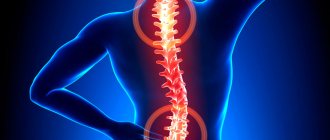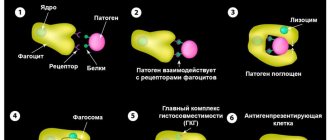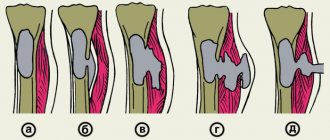Gastric outlet stenosis is a condition accompanied by mechanical obstruction (closure) of the pyloric part of the stomach or duodenum.
Causes of mechanical obstruction
- Malignant tumors such as cancer of the antrum, pylorus and duodenum. In addition, compression of the outlet section by a tumor of the head of the pancreas or bile ducts, as well as enlarged lymph nodes, for example, with lymphoma, is possible.
- Peptic ulcer of the stomach and duodenum, both in the acute stage (due to inflammation of the walls and severe swelling), and in the chronic stage with the formation of coarse scar tissue in place of previously existing ulcers of the pyloric canal or duodenum.
- More rare causes of gastric outlet stenosis may be Crohn's disease, burn stenosis after consuming aggressive liquids (acid or alkali), or chronic pancreatitis.
Clinical picture
The most characteristic signs of gastric outlet stenosis are:
- Quick feeling of fullness while eating;
- Loss of body weight;
- Nausea and vomiting after eating (without bile!);
- Belching of air with an acidic taste;
- Discomfort and pain in the epigastrium;
- Feeling of fullness in the stomach;
- “Splashing noise” is caused by jerky movements of the abdominal wall in the epigastric region with the tips of 2-3 fingers. “Splashing noise” appears when there is a significant amount of liquid and gas in the stomach (more clearly detected using a phonendoscope).
Features of treatment of stenosis. Prevention and diet therapy
This disease inherently represents a number of pathological changes and conditions. All of them are characterized by different symptoms and pathogenesis. All that unites them is only a narrowing or complete closure of the lumen of the vascular units of the body, as well as cavities and organ systems.
The mechanism of stenosis and its features
There are such types of stenosis as:
- Hereditary. Usually manifests itself as a result of congenital distortion of anatomical features.
- Acquired disorders. As a rule, their causes are metabolic disorders. However, infectious and inflammatory reactions, as well as possible neoplasms, should not be ruled out.
- Combined stenosis. This type is represented by a combination of the first and second factors. In this case, many organs are affected by narrowing (larynx, bronchi, arteries, trachea, etc.)
Types of stenosis:
- Spinal stenosis. It is a narrowing of the annals of the spinal cord, which leads to an impressive number of complications; problems with the spine
. It is both a congenital feature and an acquired disease. According to anatomy, it is divided into central and lateral. - Vascular stenosis. The cause of this type is damage to the arteries by cholesterol plaques.
- Stenosis of the trachea and larynx. It is characterized by a narrowing of the lumen in the respiratory tract, causing respiratory dysfunction.
- Pyloric stenosis. Or its other name is gastric stenosis. As a rule, the disease develops in the presence of an ulcer, causing spasms and narrowing of the spaces between the walls of the stomach.
Stenosis in centuries-old practice
Nowadays, the classical understanding of stenosis is considered to be pathological processes associated with an anomaly of narrowing of the great vessels. The ethology of the phenomenon is based on atherosclerotic processes, which are a consequence of the formation and sedimentation of cholesterol plaques on the walls of blood vessels. A deficiency of nutrients and oxygen elements in the blood has a detrimental effect on organs and leads to serious health problems.
From this we can conclude that even a person who has little knowledge of medicine can imagine how dangerous this pathology is. It is worth knowing that forms of stenosis diagnosed in time can be successfully treated surgically. Age-old practice shows that an integrated approach to the treatment of stenosis produces results immediately. In addition to surgical intervention and drug therapy, it is worth considering traditional methods that have been used for many generations. Therapeutic complexes of home therapy can be safely included in the basis of methods for the successful treatment of various types of stenosis.
Traditional medicine as one of the methods of treatment
Cleaning vessels of accumulated waste and toxins can be successfully carried out by using natural components and materials. There are a huge variety of plants that have the ability to dissolve cholesterol plaques and deposits. The ability to eliminate pathologies of arterial loops and level out anatomical disorders is the main advantage for resorting to traditional medicine at home.
In addition to drug therapy, infusions and decoctions will have an excellent effect on the body as a whole, because plant materials can replenish the required amount of nutrients and strengthen the vascular system, while normalizing the body's metabolic processes. Herbal recipes will improve the absorption of micro- and macroelements, increasing the level of vitamins. Another advantage of using traditional medicine is the convenience and ease of preparing the necessary recipes.
Prevention using traditional methods. Diet therapy
Traditional methods cannot completely cure such a serious disease as stenosis. However, it is possible to improve the patient’s general condition by getting rid of problems such as back pain
, breathing problems and reduce the number of cramps in the stomach.
- Coltsfoot tincture will improve the functioning of the digestive glands. To prepare it you will need 1 teaspoon of a mixture of flowers and leaves, poured with 200 grams of boiling water. To ensure complete readiness, leave the resulting solution for 30-40 minutes and strain. Take this recipe before meals, 100 ml.
- A decoction of golden mustache will help in the treatment of atherosclerotic conditions. All that is required is to mix golden mustache juice with plantain juice in a ratio of 1:20, bring to a boil in a steam bath and store in a dark place. Taken exclusively in the first half of the day after meals.
- Tincture of white onions with honey perfectly prevents blockage of blood vessels with blood clots. White onion juice is mixed with honey in equal parts and infused for 20 days in a cool, dark room. Take 1 tablespoon three times a day before meals. The course of therapy is 6 weeks.
- In certain cases, gruel from grated raw potatoes has a beneficial effect in an integrated approach to the treatment of stenosis. It is necessary to consume 20-30 minutes before meals, without peeling the peel, but rinsing it thoroughly.
In addition to folk recipes, the main component of successful treatment is diet.
Proper nutrition will have the best effect on the body, reducing the effects of fatty plaques on the arteries and blood vessels. First of all, it is necessary to dilute the diet with vegetables and fruits, and also reduce the consumption of spicy and fatty foods. Eliminating salt and giving up bad habits is another important factor in the treatment of stenosis. All these simple rules will help create optimal diet therapy and improve immunity, which in the future will be a huge plus not only for improving well-being, but also for the body as a whole. Author: K.M.N., Academician of the Russian Academy of Medical Sciences M.A. Bobyr
Diagnostics
Diagnostic criteria for gastric outlet stenosis:
- Clinical – the presence of symptoms of impaired gastric emptying, weight loss, signs of water and electrolyte imbalance.
- Laboratory tests - increased hematocrit, signs of metabolic hypochloremic alkalosis, hypokalemia, hypochloremia, decreased concentration of ionized calcium, hypoproteinemia, signs of metabolic alkalosis, in severe cases - azotemia.
- Instrumental - probing the stomach - evacuation of a large amount of contents with a sour or “rotten egg” smell.
- Endoscopic - narrowing of the lumen of the pyloric part of the stomach and the initial part of the duodenum.
- X-ray – slowdown or lack of evacuation of contrast from the stomach, retention of contrast in the stomach.
Photo 1: X-ray of the esophagus and stomach with barium for stenosis of the gastric outlet. Photo 2: endoscopic picture of pyloric stenosis of ulcerative etiology.
GASTRIC OUTLET STENOSIS
GASTRIC OUTLET STENOSIS is a violation of the evacuation of food from the stomach, caused by scarring of the initial part of the duodenal bulb or pyloric part of the stomach as a result of peptic ulcer, antral cancer, burn, rarely pyloric hypertrophy. 7-11% of all duodenal ulcers are complicated by stenosis. The development of cicatricial stenosis is preceded by a ulcer history of varying duration.
Symptoms, course . There are compensated, subcompensated and decompensated stages of stenosis. At the compensated stage, there are no pronounced clinical signs of the disease: against the background of the usual symptoms of a peptic ulcer, there is a feeling of heaviness in the epigastrium, heartburn becomes more frequent, vomiting of gastric contents with a sour taste, vomiting brings significant relief. X-ray shows a slight increase in the size of the stomach, increased peristalsis, and narrowing of the pyloroduodenal canal. Slowing down gastric emptying to 6-12 hours.
Subcompensation stage : increased feeling of heaviness and fullness in the epigastrium, belching with an unpleasant smell of rotten eggs. Sometimes - sharp colicky pain in the epigastrium associated with increased gastric peristalsis; the pain is accompanied by transfusion and rumbling in the abdomen. Almost daily vomiting, which brings relief. Patients often induce vomiting themselves. Characterized by general weakness, fatigue, weight loss. When examining the abdomen, visible peristalsis of the stomach and splashing noise in the epigastrium can be detected. X-ray shows gastrectasia, fluid in the stomach on an empty stomach, slower evacuation with weakened peristalsis. A day later there is no contrast in the stomach.
Stage of decompensation : feeling of fullness in the epigastrium, daily profuse vomiting. Vomit contains foul-smelling, decomposing food debris. The patients are exhausted, dehydrated, and adynamic. Thirst, dry skin, reduced turgor. Through the abdominal wall, the contours of a distended stomach and the sound of splashing in the epigastrium are visible. On X-ray examination, the stomach is significantly dilated, contains a large amount of fluid, and peristalsis is sharply weakened. Evacuation of the contrast mass from the stomach was delayed for more than 24 hours.
Pathophysiology of gastric outlet stenosis. The basis is malnutrition and water-electrolyte disorders. The consequence of water-electrolyte imbalance is a decrease in the volume of circulating fluid, blood thickening, “centralization of blood circulation,” hypokalemia, hypochloremia, and metabolic alkalosis. Signs of volemic disorders: dizziness, fainting when getting out of bed, tachycardia, decreased blood pressure, pallor and coldness of the skin, decreased diuresis. Dynamic intestinal obstruction (flatulence) is associated with hypokalemia.
As a result of volemic disorders, renal blood flow decreases, diuresis decreases, and azotemia appears. Due to renal failure, metabolic products are not removed from the blood, alkalosis turns into acidosis. With alkalosis, the level of plasma calcium decreases due to its addition to albumin. A decrease in the level of ionized calcium in the plasma changes neuromuscular excitability, and gastrogenic tetany (“chlorine tetany” by old authors) develops. Its clinical manifestations are: convulsions, trismus, Trousseau’s sign (“obstetrician’s hand”), Chvostek’s sign.
Hypochloremic and hypokalemic alkalosis, combined with azotemia, can lead to death if not properly treated.
Differential diagnosis . Cancer stenosis: very short history, rapid depletion. When palpating the abdomen, it is sometimes possible to palpate the tumor. X-ray shows no gastrectasia and hyperperistalsis (infiltration of the stomach wall by a tumor), filling defect in the antrum. The most informative diagnostic method is gastroscopy with biopsy.
With an active duodenal bulb ulcer, swelling and periulcerous infiltrate can lead to narrowing of the gastric outlet (“functional” stenosis). Antiulcer treatment for 2-3 weeks leads to a reduction in edema and infiltration with the elimination of stenosis.
Treatment . The presence of organic pyloroduodenal stenosis is an indication for surgery. Preoperative preparation should be aimed at correcting water and electrolyte disturbances. Parenteral nutrition and gastric lavage are indicated daily. The choice of surgical method depends on the stage of stenosis: for compensated stenosis, selective proximal vagotomy can be recommended with mandatory examination of the patency of the pyloroduodenal zone during the operation (if a thick gastric tube passes through the pylorus and the site of narrowing, then there is no need to perform a drainage operation). For subcompensated stenosis, vagotomy with stomach drainage surgery is indicated. In case of decompensated stenosis or when stenosis is combined with a gastric ulcer, a typical resection of 2/3 of the stomach or truncal vagotomy with antrum resection is indicated.
The prognosis is favorable.
Prevention - timely treatment (including surgery) of peptic ulcer.
Classification
By etiology:
- due to benign diseases;
- due to malignant diseases.
By stage of development:
- compensated;
- subcompensated;
- decompensated.
Complications:
- hypovolemic shock;
- acute gastrointestinal bleeding (ulcerative or mucosal ruptures due to repeated vomiting);
- perforation of an ulcer or tumor;
- spontaneous rupture of the stomach.
What is pyloric insufficiency?
This is a disease in which the muscle ring of the pylorus does not close completely, resulting in a disruption of the digestive process. Pathology is usually diagnosed:
- in older people due to weakening muscle tone throughout the body;
- in pregnant women against the background of hormonal changes;
- as a congenital pathology requiring surgical intervention.
Pyloric insufficiency may occur due to:
- pathologies of the nervous system;
- neoplasms in the digestive organs;
- gastritis, duodenitis and other inflammatory diseases;
- frequent overeating, improper diet;
- hormonal changes.
A healthy pylorus protects the sensitive intestinal mucosa from the effects of gastric juice. In addition, the food has time to break down and form chyme.
Treatment
Treatment of gastric stenosis is surgical. The goal of surgical treatment of gastric outlet stenosis is to eliminate the stenosis and restore passage through the stomach and duodenum.
Patients with sub- and decompensated stenosis require comprehensive preoperative preparation, including correction of water-electrolyte metabolism, protein composition, volemic disorders, and activity of the cardiovascular system; as well as gastric lavage and decompression.
Patients without pronounced disorders of gastric motility (stages of developing and compensated stenosis) can be operated on after a relatively short (5-7 days) period of preoperative preparation (anti-ulcer therapy, gastric decompression).
The choice of surgical intervention is determined by the disease that led to the formation of obstruction of the gastric outlet tract.
- In case of malignant etiology of the disease, examination and treatment are carried out in accordance with oncological recommendations for gastric cancer. For tumor stenosis, subtotal proximal resection or gastrectomy in combination with lymphadenectomy is performed.
- For cicatricial stenoses of benign origin, it is necessary to perform either organ-preserving drainage operations (pyloroplasty in various modifications, gastrojejunostomy bypass) or distal gastrectomy. In case of ulcerative stenosis, a standard resection of 2/3 of the stomach is performed with an anastomosis according to Billroth 1 or Billroth 2 in various modifications, depending on the conditions for the anastomosis and the formation of the duodenal stump. All surgical treatment options are possible using minimally invasive technologies in the absence of contraindications.
Pyloroplasty according to Heineke-Mikulicz
Treatment of stenosis of the stomach and duodenum
Treatment is always surgical. Before the operation, the metabolism is adjusted. To do this, the patient is injected with solutions of dextran, albumin, glucose, saline solution, and electrolyte solution. In addition, it is necessary to constantly remove the contents of the stomach through a tube to reduce pressure on its walls. To replenish energy losses, patients are prescribed parenteral nutrition. About a week after such preparation, the operation is performed. This may be gastric resection, expansion of the duodenum, vagotomy, etc.
The prognosis depends on the stage of the disease. With late diagnosis, complications that are incompatible with life develop.
Treatment in the department of thoracoabdominal surgery and oncology
Treatment in the department is carried out under the programs of compulsory medical insurance, voluntary medical insurance, VMP, as well as on a commercial basis. Read how to get treatment at the Department of Thoracoabdominal Surgery and Oncology of the Russian Scientific Center for Surgery.
To schedule a consultation, call:
+7 (499) 248 13 91 +7 (903) 728 24 52 +7 (499) 248 15 55
Submit a request for a consultation by filling out the form on our website and attaching the necessary documents.
Surgery for spinal stenosis
Doctors at the Pirogov Clinic treat degenerative stenoses both conservatively and surgically. All spine surgeries are performed using the latest endoscopic or microsurgical technology, as well as X-ray or radiofrequency equipment.
In most cases, preference is given to endoscopic operations for spinal stenosis
. They allow you to avoid the installation of implants - with the exception of cervical stenosis and cases where spondylolisthesis and instability of the spinal segment are also observed. In addition, such operations are characterized by maximum controllability, minimal risks, and for patients, rapid recovery after endoscopic surgery for spinal stenosis is tolerated most comfortably. The pain in the legs goes away immediately after the operation, and hospitalization in the clinic is only 1 day.
Find out more about endoscopic spine surgeries.
Stenosis surgery performed using microsurgical method
, also refers to minimally traumatic interventions. It is advisable (and may even be the only solution) if, along with expansion of the spinal canal and decompression of the spinal roots, stabilization of the spinal segment is necessary. Such operations show good clinical results and, unlike traditional open spinal surgeries, allow the patient to recover quickly and avoid the risk of disability.
Unfortunately, sometimes it is impossible to do without the installation of metal structures and endoscopic surgery is impossible. A difficult case from the practice of neurosurgeon Mereja Amir Muratovich
. The patient developed stenosis complicated by spondylolisthesis due to displacement of the vertebrae, which caused acute compression of the roots of the spinal canal. To avoid destabilization of the L4-L5 spinal segment and avoid severe consequences in the future, it was decided to fix the segment with screws and install an interbody cage. The operation was performed with pinpoint precision—the pain and weakness in the patient’s legs disappeared immediately after the intervention. The case was difficult and exceptional, but thanks to the experience and skill of our specialists, the patient was able to recover within 1 day.
Find out more about microsurgical operations on the spine.








